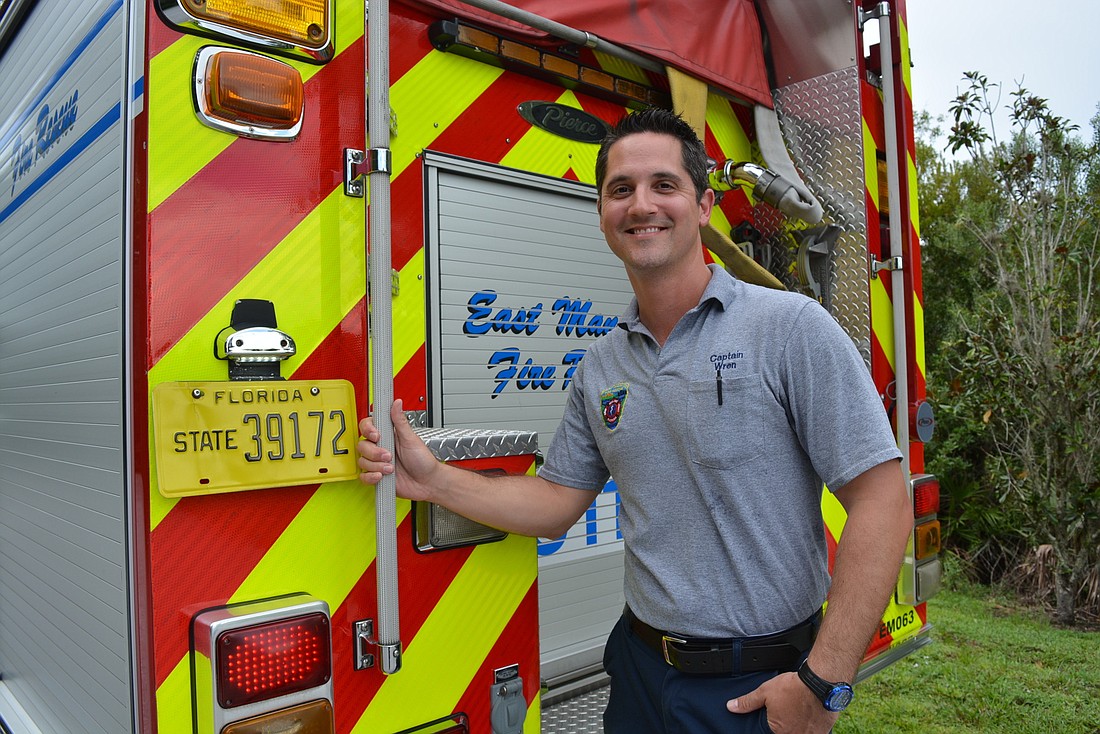- April 18, 2024
-
-
Loading

Loading

When East Manatee Fire Rescue District Capt. Paul Wren hears a call dispatched to Interstate 75, his heartbeat races a bit more than usual.
The interstate means more vehicles at higher-than-normal speeds and poses greater risk to first responders.
“I-75 is definitely a specific hazard that we and North River [Fire District] face,” he said. “It’s an especially dangerous roadway because of the speeds and the construction. A lot of people are in a hurry or distracted.”
On Aug. 22, an East Manatee Fire Rescue firetruck was responding to a call — a pickup truck had veered off the road and into the median just before Kay Road on I-75 — when the truck itself was struck from behind by an approaching
vehicle.
East Manatee Fire Rescue District Chief Lee Whitehurst said the firetruck’s wheels were still moving — it had not fully stopped to assess the scene — when the accident occurred.
Firefighters, surprised by being hit, had to regroup and begin triaging the situation. They were evaluating the condition of their firetruck, which was leaking diesel fuel, as well as trying to understand the status of the initial accident and rendering aid to the driver, Bernadetta Hopton, of Tampa, who hit them. She was transported to Blake Medical Center for “incapacitating” injuries, according to a Florida Highway Patrol report. (Hospital spokeswoman Lisa Kirkland said she could not provide a status of Hopton’s condition or whether she was a patient.)
“That’s difficult,” Whitehurst said. “We’re in the business of helping people. The person who hit us — we care. We’re worried about her. Firetrucks can get replaced. People can’t.”
Whitehurst said the 13-year-old pumping engine had a depreciated “book value” of $67,000, but costs to repair it were estimated at $150,000. Only a $9 piece of equipment was damaged.
“We’d rather it be that than our guys,” Whitehurst said.
The district has two other reserve trucks, so it was able to get firetrucks on the road again within hours of the accident.
A new firetruck for the future Station 7, to be located off Covenant Way in Lakewood Ranch, arrives in October and will give the district a third backup truck until that station opens in spring 2020. It cost $705,000 plus equipment. Getting a new firetruck, from design to delivery, can take up to one year. East Manatee Fire placed an order for a second fire truck, which will be ready in about one year, Sept. 5.
Whitehurst said having one fewer truck, at least temporarily, crimps the district’s plans to have four reserve vehicles. However, it should not impact levels of service.
Whitehurst said the district has procedures, such as putting out cones, to ensure drivers see firetrucks. There are even arrow lights on the back of trucks to tell motorists to move over. However, accidents still occur. East Manatee had another truck hit by a vehicle in October 2017.
By Florida law, motorists are supposed to stay at least 500 feet behind a moving firetruck. Whitehurst said the distance is important because firefighters are looking for the accidents to which they are responding.
“You have to be able to react,” Whitehurst said.
Wren said the district has been proactive in ensuring safety, such as by swapping out blue and white fluorescent reflective tape on the back of trucks with more visible yellow and white tape. It also has been intentional about training initiatives and uses a systematic approach to responses.
On I-75, for example, trucks are parked at an angle into a lane of traffic for visibility. Firefighters respond in front of the vehicle, so if the truck gets hit, oncoming traffic is deflected away, which keeps firefighters safe.
Wren said incidents like the one in August give firefighters a heightened sense of awareness when responding to calls, especially in highly trafficked areas.
“The danger is real when you’ve had the [accidents] we’ve had,” he said. “It puts you into hyper-vigilant mode.”